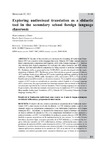Exploring Audiovisual Translation as a Didactic Tool in the Secondary School Foreign Language Classroom

Use este enlace para citar
http://hdl.handle.net/2183/31523
A non ser que se indique outra cousa, a licenza do ítem descríbese como Atribución 4.0 Internacional
Coleccións
- Investigación (FEDU) [939]
Metadatos
Mostrar o rexistro completo do ítemTítulo
Exploring Audiovisual Translation as a Didactic Tool in the Secondary School Foreign Language ClassroomData
2022Cita bibliográfica
Bobadilla-PérezM., & Carballo de SantiagoR. J. (2022). Exploring Audiovisual translation as a didactic tool in the Secondary school foreign language classroom. Porta Linguarum An International Journal of Foreign Language Teaching and Learning, 81-96. https://doi.org/10.30827/portalin.vi.22307
Resumo
[Abstract] The aim of this research is to showcase the versatility of Audiovisual Translation (AVT) as a resource in the language classroom. Didactic AVT helps students improve their communicative competence and linguistic skills in the foreign language (L2). Students also develop their digital competence by working with online resources and AVT editing software, and their intercultural competence by being exposed to authentic material in their L2. Mediation skills, as promoted by the CEFR (2001), are also developed with the implementation of didactic AVT. The literary review first introduces general concepts of didactic AVT, and later breaks down different AVT modes to focus on the benefits and potential downsides as classroom resources inherent to each one: subtitling, dubbing, subtitling for the deaf and hard of hearing (SDH) audio description (AD), and creative AVT. With the intention of exemplifying some practical applications of AVT modes as central tasks in Secondary school EFL classrooms, this paper presents four learning sequences which are based on the theoretical principles reported in the reviewed literature. These learning sequences are not meant to be prescriptive, but rather an example of potential ways to implement AVT in the classroom. [Resumen] El objetivo de esta investigación es mostrar la versatilidad de la Traducción Audiovisual (TAV) como recurso en el aula de idiomas. La TAV didáctica ayuda a que el estudiantado mejore su competencia comunicativa y sus habilidades lingüísticas en la lengua extranjera (L2). Así mismo, se desarrolla la competencia digital al trabajar con recursos en línea y software de edición de TAV, y su competencia intercultural al estar expuestos a material auténtico en la L2. La revisión literaria introduce, en primer lugar, conceptos generales de la TAV didáctica, y, a continuación, desglosa diferentes modelos de TAV centrándose en los beneficios y posibles inconvenientes como recursos de aula inherentes a cada uno de ellos: subtitulación, doblaje, subtitulación para sordos y con problemas de audición (SDH), audio-descripción (AD) y TAV creativa. Con la intención de ejemplificar algunas aplicaciones prácticas de los modelos de TAV en al aula de lengua extranjera en Educación Secundaria, este artículo presenta cuatro secuencias de aprendizaje que se basan en los principios teórico-didácticos considerados en la literatura referenciada. Estas secuencias de aprendizaje no pretenden ser prescriptivas, sino más bien un ejemplo de posibles formas de implementar TAV en el aula.
Palabras chave
Audiovisual Translation (AVT)
Didactic AVT
Secondary education
Foreign language learning (FLL)
Traducción Audiovisual (TAV)
TAV didáctica
Educación secundaria
Aprendizaje de lenguas extranjeras
Didactic AVT
Secondary education
Foreign language learning (FLL)
Traducción Audiovisual (TAV)
TAV didáctica
Educación secundaria
Aprendizaje de lenguas extranjeras
Versión do editor
Dereitos
Atribución 4.0 Internacional






